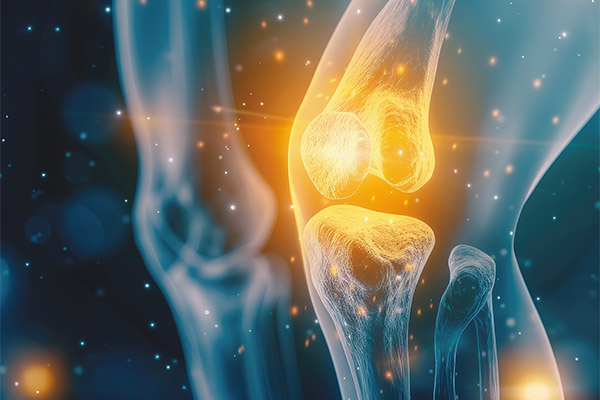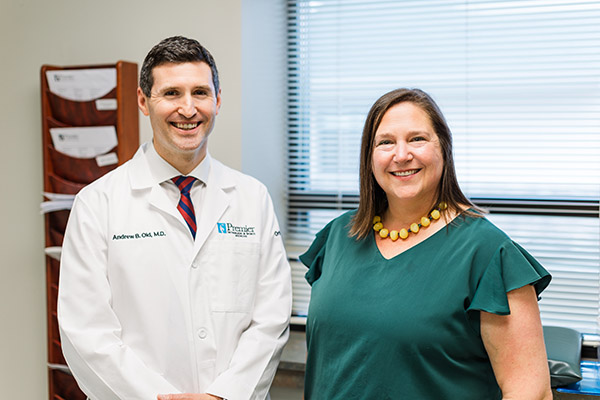
Robot-assisted knee replacement surgery at Chester County Hospital got Christy Hofmanner back on her feet.
Despite her increasing immobility, 47-year-old Christy Hofmanner was surprised to learn that the cartilage in her knees had almost completely worn away. To correct the more troublesome knee, she underwent a state-of-the-art procedure at Chester County Hospital.
Christy Hofmanner could no longer ignore that she was having a difficult time lowering herself to the floor and standing back up. As a preschool teacher at a Montessori school, this was a problem.
Gradually, the pain in her knees began to affect other aspects of her life. She lives just outside West Chester Borough and enjoys walking through town. But, anymore, it took everything she had to walk from her car into her home at the end of the day.
Hofmanner was at her wit's end when she scheduled an appointment with Andrew B. Old, MD, Orthopaedic Surgery, Chester County Hospital. X-rays showed she had advanced osteoarthritis. The cartilage had worn away in both of her knees, leaving bone rubbing against bone. Although, the deterioration was less severe in her left knee.
Hofmanner was 47 at the time. Her mother had a knee replaced, but she was in her 60s when she had her surgery. Dr. Old says that osteoarthritis, while more common in older adults, is not unusual in people under 50. It can be brought on by a serious injury. Professions that cause a lot of wear and tear on joints, like Hofmanner's, can also lead to osteoarthritis.
Dr. Old prescribed two months of physical therapy, but Hofmanner's pain persisted. Next, she was given a steroid injection in each knee. That worked very well. For eight months, Hofmanner felt like a new woman. But the next round of injections managed to hold her pain at bay for only two months.
At that point, Dr. Old shifted course and injected Hofmanner’s knees with Euflexxa, which works by replenishing some of the hyaluronic acid that's been lost, helping with lubrication and shock absorption in the joint.
The first round of Euflexxa injections provided her with six pain-free months, but the second round didn't have any effect whatsoever.
Increasingly, Hofmanner, who is an avid traveler, was feeling in by her physical limitations. She could live her life as she normally would on good days. On bad ones, she could barely get around her three-story townhouse.
From their first meeting, Hofmanner appreciated Dr. Old's straightforward nature. Having exhausted all the available "conservative measures", he told her it was time to consider replacing the more problematic right knee. With several trips on the horizon, she agreed.
Progress Impeded

Dr. Old replaced Hofmanner’s right knee at Chester County Hospital on June 5, 2023. He performed the surgery with the assistance of the state-of-the-art Zimmer Biomet Rosa Knee System. He estimates that at least 75 percent of the knee replacements he did last year were robotic-assisted.
He says the main advantage of robot-assisted knee replacement is that it's a more precise procedure. The surgery has traditionally been done, to an extent, through feel.
"When we do the knee replacement without the robot, we're making some assumptions for each patient, within a set of parameters," Dr. Old says. “With the robot, I can customize the surgery to the patient's anatomy. The key to knee replacement surgery is balancing the ligaments, and the robot can help me with that. It also allows me to rotate the implant based on the objective data it’s providing."
Dr. Old says a difference in patients' experience or their recovery has yet to be quantified in the articles that have been published in peer-reviewed journals comparing robotic and conventional knee replacement surgeries. But he speculates that may be because the metrics have not yet caught up to the technology.
"I’m not doing as much soft tissue dissection or ligament releases with the robot as I do manually because the robot tells me how much I need to free up," he says. "And so, I'm hopeful that might be providing patients with a little less pain and a little faster recovery."
Hofmanner was walking four hours after her surgery. And, after successfully completing a series of mobility challenges the next morning, she was discharged.
"It was a very different process from what my mom went through," she says. "She was in the hospital for two or three days after her surgery and she was much more stationary."
Hofmanner admits the first couple weeks were a struggle. But she knew her recovery would be akin to a marathon; Dr. Old told her she could expect to feel back to normal within eight to 10 months.
She dutifully attended her physical therapy sessions at Premier Orthopedics throughout the summer. By October, her range of motion was where it should have been, but Hofmanner was concerned that she continued to experience pain in her right leg. At the recommendation of her physical therapist, she scheduled another appointment with Dr. Old.
An x-ray of her right hip revealed it was in even worse shape than the knee had been. Dr. Old recommended she have the troublesome hip replaced, even though she was less than five months removed from her last surgery.
"I have a big summer coming up," she says. "My son's graduating from high school, and I’m taking my mom to Venice. The thinking was, the longer we wait, the more this is going to interfere with all of that."
So, the day after her class's holiday party in December, Hofmanner had her second major surgery.
Reason To Be Optimistic

Knee replacement recipient Christy Hofmanner and Chester County Hospital orthopaedic surgeon Andrew Old, MD.
This could just be Hofmanner trying to put a positive spin on recent events in her life, but she says that the second surgery was surprisingly easy compared to the first.
"Three days after my hip surgery, I didn’t need a walker," she says. "And I was like, 'Wait, this is it?' There wasn't much swelling or pain. Even the physical therapy exercises, by comparison, are ridiculously easy."
It's not just Hofmanner's perception, says Dr. Old, who does not use a robot for hip replacement surgeries.
"A hip replacement is a much better tolerated operation from a patient's standpoint," he says. "That's actually one of the main factors that led me to robotic knee replacements."
Satisfaction rates for hip replacement surgery, he says, average better than 95 percent, whereas satisfaction rates for knee replacement surgery tend to reside around 85 percent.
"I see that 15 percent of people who don’t like their knee replacement as a huge opportunity for the medical field to try to play catch up," Dr. Old says. "The hip replacement is a fantastic operation, and the knee replacement is not. That's just the reality. But there are many surgeons like me who see this as a tremendous opportunity for change. And I believe we're closing the gap in increments."
"Everybody’s anatomy is not the same," he continues. "And yet, we've treated everyone with this bell-curve approach. Robotic knee replacement is changing the paradigm by enabling surgeons to tailor the surgery to the patient. It's just scratching the surface, but it's already clear this is the way forward."
Meanwhile, Hofmanner concedes that she'll likely need to have her left knee replaced too, but Dr. Old believes that's a conversation that can wait a few years.
More pressing is her son's graduation in June. To celebrate, she's taking him to a resort in Punta Cana, Mexico. Soon after, she'll travel to Italy with her mom, a once-in-a-lifetime experience.
They'll return just in time for Hofmanner to help move her son into college.
And she's looking forward to doing all of it free of pain.
Did You Know That Our Orthopaedic Team Helps Patients Do What Once Seemed Impossible By Using The Most Advanced Technology?